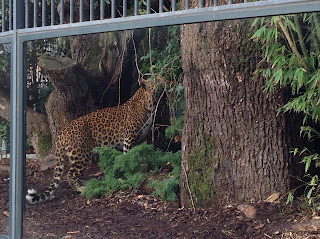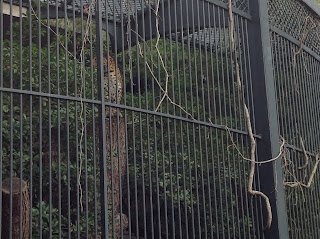An historical sign (above) is on the fence near the Main Entrance....
Image below " Animal artists at the Jardin des Plantes, Paris. From the magazine "L'Illustration", 7 August 1902." from Wikepedia
A trip to the zoo in Paris is also a history lesson ...
The Menagerie opened in 1794. It's one of the oldest zoos in the world. While the enclosures have been updated for the modern comfort of the animals, the buildings date the early 1800s... the 1920s and 30s... and have been classified as historical monuments.
There are no large animals (Elephants, Lions, Rhinos etc) at the Menagerie today. The modernized enclosures are comfortable for the current guests -- hooved stock, birds, small to medium sized mammals, reptiles, monkeys, and large cats like a panther and some lynx. (There is a modern zoological garden today in Vincennes, near Paris). http://parczoologiquedeparis.fr/en )
When you walk the cobblestone paths around the zoo... it's like being swept back in time. You can imagine the history of the exotic animals that were rounded up during the French Revolution and brought here to the safety of the Menagerie.
The Menagerie was founded by Jacques-Henri Bernadin de Saint-Pierre (1737-1814). Saint-Pierre was a explorer of the natural world of the West Indies and the island of Mauritius. These experiences contributed to the children's book "Paul et Virginie" he wrote in 1788 --- A romantic tale of a young couple who lived off the land in a tropical paradise, the story also touched on the themes of ecology, slavery and class structure. It was wildly popular in its time.
The young figures of Paul and Virginie can be seen on the base of this statue of Saint-Pierre, on the grounds at the Jardin des Plantes...
The themes of the Saint-Pierre's novel -- people living in balance with nature -- reflected his own interests. He was an early proponent of vegetarianism. Exotic animals in the late 1700s were traded as political gifts, kept as pets and symbols of wealth by nobility, or displayed as side show attractions. Saint-Pierre had studied wild animals in nature. The Menagerie expressed his desire to balance scientific research with better care for the animals
Directors of the Natural History museum... early heroes of scientific thought and learning, like Buffon, Cuvier, and Saint-Pierre ... were the pioneers of natural science. Their foresight to study, care for, and conserve the wide range of specimens that came into France helped establish Paris as the scientific heart and soul of Europe. (Map below shows the Menagerie, along with the other buildings of the natural history museums).
Today, the main entrance of the Menagerie ....
Takes visitors on the path to the Rotunda --- an historic building from 1804.
The Rotunda today is guarded on one side by these statues of hippos...
And on another by this impressive bear...
Most visitors can only peer into the doors and imagine the history-making encounters that happened here. Some of the animals at the Menagerie were the very first of their species ever exhibited in Europe.
Photo below was taken through the class door. It show maps on the wall indicating the interior of the Rotunda and the outside enclosures...
A walk around the Rotunda reveals cut-outs of former residents like big cats...
The pool in the outdoor enclosure below may be used these days by a large Tortoise sometimes housed here.
Historically -- the outdoor enclosures where home to rhinos, giraffes and elephants.
School groups... and other visitors.. enjoy seeing the current residents at the Menagerie...
One enclosure featured some "exotic" north american wildlife...
Snow Leopard!
Outside...
and inside...
The renovated Lion House --- build in the 1930s!
Lush outdoor enclosures for the cats....close encounter viewing for the spectators!
Signs use comic drawing to remind visitors they are GUESTS!
During the day....
History surrounds you at the Menagerie....
Explore this garden of delights!




















































































No comments:
Post a Comment